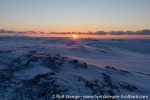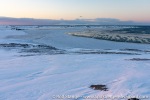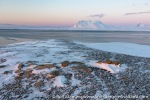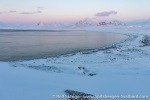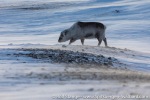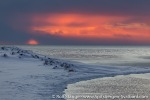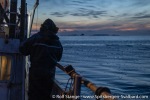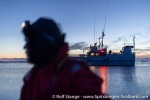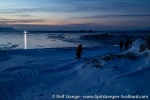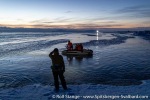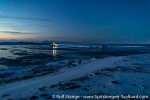-
current
recommendations- Liefdefjord
New page dedicated to one of Spitsbergen's most beautiful fjords. Background information and many photos.
- New Spitsbergen guidebook
The new edition of my Spitsbergen guidebook is out and available now!
- Liefdefjord
New page dedicated to one of Spitsbergen's most beautiful fjords. Background information and many photos.
Page Structure
-
Spitsbergen-News
- Select Month
- May 2025
- April 2025
- March 2025
- February 2025
- January 2025
- December 2024
- November 2024
- October 2024
- September 2024
- August 2024
- July 2024
- June 2024
- May 2024
- April 2024
- March 2024
- February 2024
- January 2024
- December 2023
- November 2023
- October 2023
- September 2023
- August 2023
- July 2023
- June 2023
- May 2023
- April 2023
- March 2023
- February 2023
- January 2023
- December 2022
- November 2022
- October 2022
- September 2022
- August 2022
- July 2022
- June 2022
- May 2022
- April 2022
- March 2022
- February 2022
- January 2022
- December 2021
- November 2021
- October 2021
- September 2021
- August 2021
- July 2021
- June 2021
- May 2021
- April 2021
- March 2021
- February 2021
- January 2021
- December 2020
- November 2020
- October 2020
- September 2020
- August 2020
- July 2020
- June 2020
- May 2020
- April 2020
- March 2020
- February 2020
- January 2020
- December 2019
- November 2019
- October 2019
- September 2019
- August 2019
- July 2019
- June 2019
- May 2019
- April 2019
- March 2019
- February 2019
- January 2019
- December 2018
- November 2018
- October 2018
- September 2018
- August 2018
- July 2018
- June 2018
- May 2018
- April 2018
- March 2018
- February 2018
- January 2018
- December 2017
- November 2017
- October 2017
- September 2017
- August 2017
- July 2017
- June 2017
- May 2017
- April 2017
- March 2017
- February 2017
- January 2017
- December 2016
- November 2016
- October 2016
- September 2016
- August 2016
- July 2016
- June 2016
- May 2016
- April 2016
- March 2016
- February 2016
- January 2016
- December 2015
- November 2015
- October 2015
- September 2015
- August 2015
- July 2015
- June 2015
- May 2015
- April 2015
- March 2015
- February 2015
- January 2015
- December 2014
- November 2014
- October 2014
- September 2014
- August 2014
- July 2014
- June 2014
- May 2014
- April 2014
- March 2014
- February 2014
- January 2014
- December 2013
- November 2013
- October 2013
- September 2013
- August 2013
- July 2013
- June 2013
- May 2013
- April 2013
- March 2013
- February 2013
- January 2013
- December 2012
- November 2012
- October 2012
- September 2012
- August 2012
- July 2012
- June 2012
- May 2012
- April 2012
- March 2012
- February 2012
- January 2012
- December 2011
- November 2011
- October 2011
- September 2011
- August 2011
- May 2011
- April 2011
- March 2011
- February 2011
- January 2011
- December 2010
- November 2010
- September 2010
- August 2010
- July 2010
- June 2010
- May 2010
- April 2010
- March 2010
- February 2010
- November 2009
- October 2009
- August 2009
- July 2009
- June 2009
- May 2009
- April 2009
- March 2009
- February 2009
- January 2009
- December 2008
- November 2008
- October 2008
- August 2008
- July 2008
- June 2008
- May 2008
- April 2008
- March 2008
- February 2008
- April 2000
- Select Month
-
weather information
-
Newsletter

| Guidebook: Spitsbergen-Svalbard |
Home →
Yearly Archives: 2022 − News & Stories
Sun festival in Longyearbyen
The sun festival (solfest) is an important highlight in the annual calendar for many in Longyearbyen. It is traditionally celebrated on 08 March, when the first direct rays reach Skjæringa, the oldest part of Longyearbyen. On this day, a large crowd comes together at the stairs of the old hospital (which does not exist anymore) close to the church.
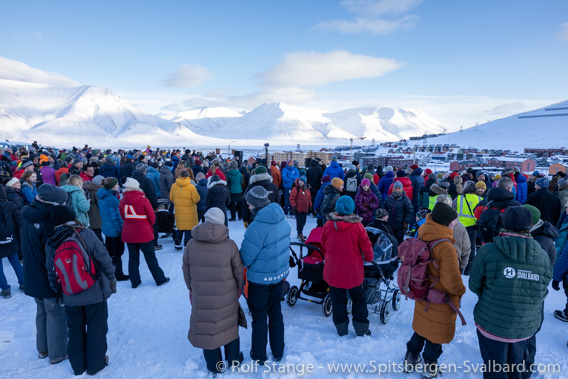
Sun festival (Solfest) in Longyearbyen.
This was also what happened in good tradition this time, although clouds on the southern horizon threatened to spoil the event. Many locals and certainly also a number of tourists gathered to celebrate the return of the light. The traditional programme includes singing, and when the sun was fighting to get through around 12.45 hours, she was lively cheered to until she indeed finally came out, to everybodies great delight!
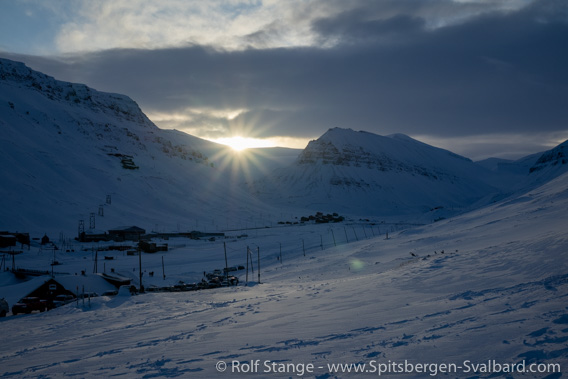
Sun festival in Longyearbyen: “Here comes the sun” 🙂
Talk of luck – soon, the horizon disappeared again behind a grey curtain of clouds.
The sun festival is actually nmore than “just” the 08th of March, it is a whole week with a series of various cultural events. Some of them, such as the traditional revye that always comes with the solfest, have to be postponed by several weeks because too many of the artists are currently fighting Covid-19 🙁
From Farmhamna to Longyearbyen
Tue
8 Mar
2022
I have returned to Longyearbyen after five weeks in Farmhamna. Back to civilisation – well, in a wider sense. Longyearbyen, anyway. And in time for the sun festival, the second one this year for me. We had one in Farmhamna already on 16 February 🙂
The time I spent in Farmhamna was plainly wonderful. Rich and full in experiences and impressions. Stunning and interesting. A lot of food for an arctic-hungry soul and for a similarly minded camera.
But this chapter is over now for me. I have been a little lazy in Farmhamna concerning writing here, I spent most of the time there in the “here and now”. I have to get back to that. But not now.
Farmhamna is not the end of the world, but not far from it either. Getting there and away is not just done easily and quickly, as these pictures may illustrate:

Surf can always make life difficult on the west coast (and elsewhere) …
So far, this year seems to bring a lot of ice to the “cold coast” (Svalbard), at least in relation to recent standards. There is quite a bit of ice even on the west coast right now, as the ice chart shows. Too often, there has been hardly any ice at this time of year in recent years.

… and ice isn’t an unknown phenomenon in Spitsbergen either.
Also in the Farmhamna area, there has been quite a lot of ice in recent weeks. At times, the little peninsula was completely blocked from all directions, and other bays in the area were also filled with ice. Not necessarily thick and solid, but enough to keep a boat from getting there.
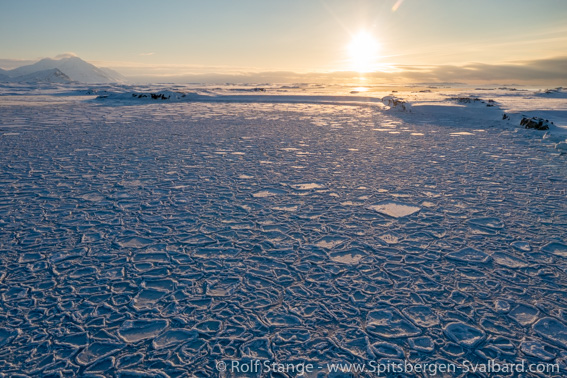
This is what the bay Farmhamna has been like the last couple of weeks.
The combination of surf on one side of the peninsula and ice on the other side added some extra excitement (and sweat) to the exchange operation, where I left Farmhamna and Rico got his family back. Finally it worked. The two Henningsens of Hennningsen Transport and Guiding in Longyearbyen made it possible with their little but strong ship Farm (there is indeed a relationship between the place and the boat, as the name suggests) and some good Zodiac driving to shuttle people and cargo in and out in challenging conditions.
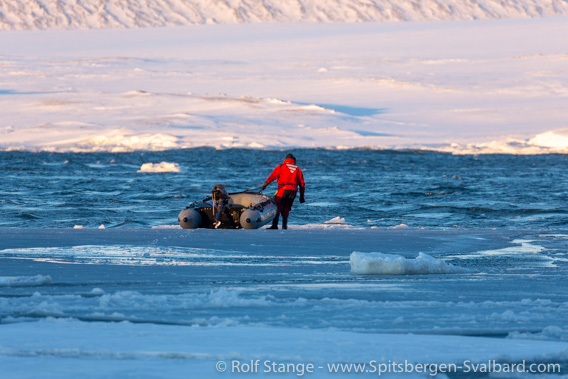
Zodiac operation in icy waters.
On board, there was a small group of people, including Kristina, who were there for the rare opportunity of a visit to Farmhamna. This did unfortunately not work out, given the conditions. Instead, they got a fair bit of rock’n’roll on the boat at times. In the end, we were happy that we could make the key part of the operation work. Don’t ever take anything for granted on and around these islands!
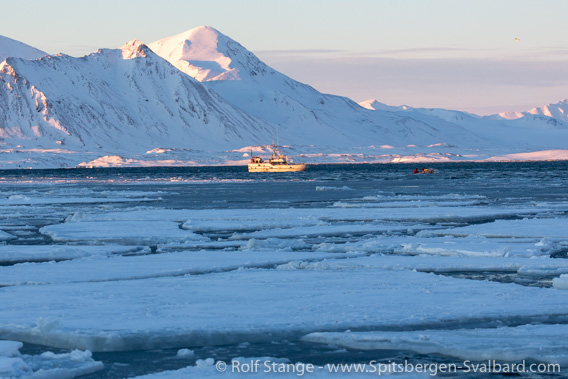
Farm in position in Farmhamna.
Local tourism inter-trade organisation against boycott of Russian settlements
While the Russian war is raging in the Ukraine, many are asking in Longyearbyen how to deal with the Russian neighbours in Barentsburg, where part of the population is Ukrainian, and the largely abandoned settlement of Pyramiden.
The important winter tourism season has started, and the many tourism companies in Longyearbyen were looking forward to the season after two very difficult corona years. Day trips to Barentsburg have, so far, been amongst the most popular offers; Pyramiden is also an important destination, although less frequently visited than Barentsburg because if it further away.
Now many in the industry are wondering how to deal with these offers considering the Russian aggression, war and crimes in the Ukraine and the international reactions. The local tourism inter-trade organisation Svalbard Reiselivsråd has taken the question upn and discussed it between their members and with authorities.

Barentsburg: usually a popular destination, now controversial.
As a result, Svalbard Reiselivsråd does not recommend to boykott the Russian settlements. The organisation argues that sanctions should be measures on a governmental level but not on a local, private sector level, where a boykott is more likely to hit people locally rather than the Russian government and others who are responsible for the current war and crime in the Ukraine. Svalbard Reiselivsråd indicates that they understood from Oslo authorities that a normal relationship is desired on a local level, according to Svalbardposten.
Some members had argued for a boykott of the Russian settlements, and clients had cancelled their bookings. According to Svalbard Reiselivsråd, it is up to every company not to offer trips to Barentsburg or Pyramiden, and it is anyway up to every tourist to book a tour to these settlements or not.
Black February
Of course it had been my intention for a while already to write again here. But life in Farmhamna is mainly happening offline, and that is good.
And now the world isn’t anymore what it used to be. The whole population of Farmhamna (currently two people) is deeply shocked about the news that reach us here. It would just feel completely out of place to write about the beauty of the nature here in the far north and about the simple, but good life in a remote trapper station while the world is on fire.
It is about 40 kilometres from Farmhamna to Barentsburg as the fulmar flies. We can see the light of Barentsburg reflected by low clouds in certain weather conditions. It is not far at all. Barentsburg is a Russian settlement, but with many Ukrainians amongst its 300-400 inhabitants. So far, Russians and Ukrainians were living there together peacefully, also after the Russian occupation of the Krim peninsula and the conflict in the eastern Ukraine since then. How do people feel there now? How are they, with the knowledge about the situation in their respective home countries? Impossible to imagine for me. Sysselmester Lars Fause is in regular contact with Barentsburg, following normal routines, and says that it is a “good and normal dialogue”, without going into further detail.
So I finish my contributions here for February with the following picture, which is currently often shared in social media to express the horror about the situation, protest against the Russian invasion and war in the Ukraine and complete digust for those who are responsible for it.

The Ukraine
On skis to Eidembukta
Sat
19 Feb
2022
The days are quickly getting longer after the return of the sun. This is indeed an amazingly quick process. Just 2-3 days after the very first sunrise of the year, the sun is already for several hours above the horizon.
The fact that we have a clear sky again after more than a week of clouds does, without a doubt, also contribute to the subjective part of this impression.
Time to get out and see a bit more of the surroundings. Some of you may know Eidembukta from the sailing ship tours in the summer season. This large bay is just a few kilometres north of Farmhamna.
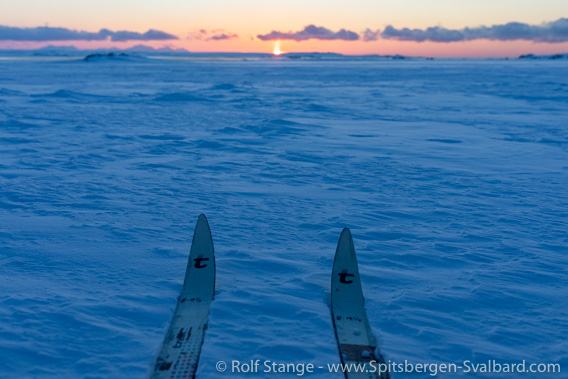
Skiing from Farmhamna to Eidembukta. Towards the sun 🙂 at least for a while.
Staying outside for some time is indeed a refreshing experience, with temperatures around -15 degrees (C) plus windchill. It is much, much less windy than in parts of NW Euope up here these days, but there is a pretty constant breeze blowing, which feels quite icy.
I schedule the day in such a way that I make use of the sunlight as much as possible, but the idea to see and photograph Farmhamna from a distance with the sunset in the background fails due to a bank of clouds. It doesn’t matter. There is beauty all around me wherever I turn my eyes. The wide, open, snow-covered land with soft colours ranging from red through pink to blue, the drift snow being blown over the low hills. The large and beautifully curved coastline of Eidembukta. I follow the beach for a bit without finding a single piece of driftwood, to my surprise. A little canyon sculptured by the meltwater river of Venernbreen, one of the nearby glaciers. I follow the canyon for a bit, keeping a good eye on the cornices, but wherever they look scary, there is enough space to stay away from them.
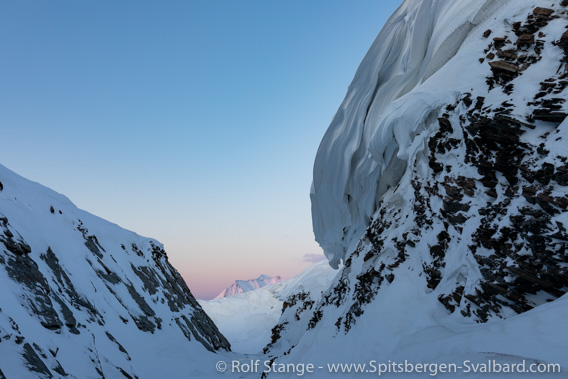
Canyon in Eidembukta.
I see some lonely reindeer on the way back. The only living creatures out here today, apart from a glaucous gull and a few northern fulmars.
I try to find a sheltered place for a lunch break, but my spot under a little rock cliff turns out to be the windiest and coldest place anywhere around. I don’t stay long and rather return to the hut with the cozy wood-burning stove.
- gallery anchor link: #gallery_2187
Click on thumbnail to open an enlarged version of the specific photo.
Sun festival in Farmhamna
Wed
16 Feb
2022
In Longyearbyen, 8 March is the day to celebrate the return of the sun, mainly because the place is surrounded by mountains, especially to the south.
Not so here in Farmhamna 🙂 so we had the pleasure to see and celebrate the sun already today, 16 February. It is the first sunrise after 112 days, the last one before had been on 25 October. As far as I am concerned, I have been here now for not even 3 weeks and still, it is quite special to see the sun again. Let alone for Rico, who hasn’t seen the sun for months!
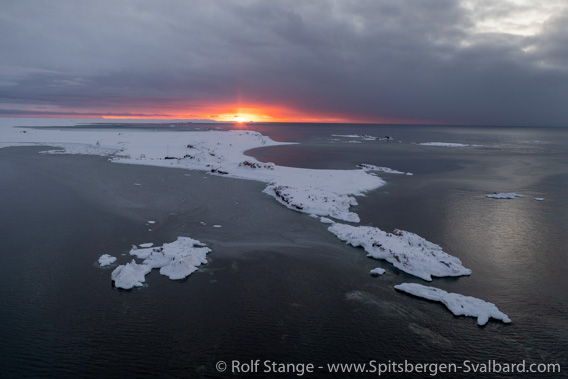
Clear view to the south: no problem in Farmhamna.
So we made sure we were there well in time, up on the “telephone hill”, and we also made sure we were well equipped with cameras, some standing on legs, another one with wings – the whole lot.
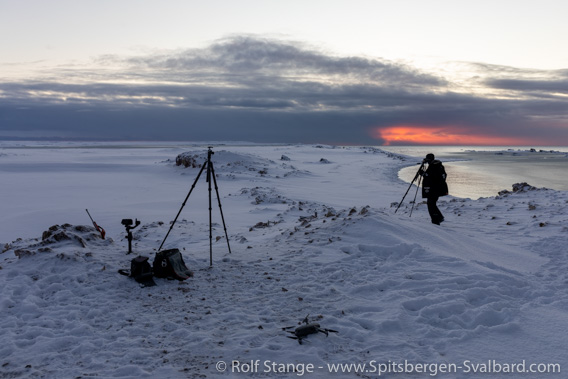
“Sun festival” in Farmhamna. It wasn’t really a mass gathering.
And we were lucky, because during the morning the sky had been completely cloudy. But just in time we got a low stripe of sky clear enough between the clouds and the horizon in the south, where the orange glow became brighter and brighter, and finally, there she was, the sun – what a view, what a moment!
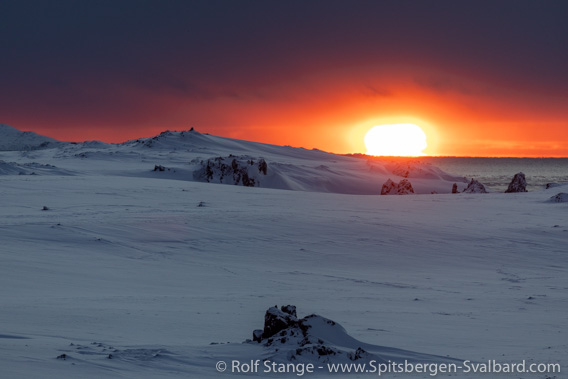
The first sunrise after 112 days.
Later in the afternoon, the clouds covered the whole sky again. Talk of luck!
If you want to read a bit more about midnight sun and polar night, click here.
And here, some more impressions about this beautiful day in Spitsbergen.
- gallery anchor link: #gallery_2184
Click on thumbnail to open an enlarged version of the specific photo.
Farmhamna
Fri
11 Feb
2022
Now I have already been here in Farmhamna on Spitsbergen’s west coast for a while and some are wondering how things are up here, so far north in the polar night. Well, indeed, when I am travelling the same area under sail during the summer, my travel blog updates are a bit more regular. But the days are not only beautiful but also usually well filled with work and other activities and the meaning of life in such a place is probably not to spend every minute possible on the computer, is it? 🙂

Farmhamna: Trapper station on Spitsbergen’s west coast.
I will write more here later, but to start with, I thought that I should introduce this beautiful and unusual place, so I have created a dedicated Farmhamna page (click here to open). It has the 360 degree panoramas that you may know from similar pages in that section of this website, but also two photo galleries with images from both summer and winter, the latter ones also giving some idea of what Rico, I and the 7 doggies are doing here these days.
Data cable between Spitsbergen and mainland Norway damaged by human action
The damage that occurred to one of the two communication cables that connect Spitsbergen to north Norway a few weeks ago attracted a lot of public attention (click here for more information). The case is by no means settled, but the owner of the cable, Space Norway, and the responsible police agency of Troms in north Norway have been in the area and were able to gather first data with an underwater robot.
According to NRK, the police told Norwegian media that human action appears to be likely as the cause for the damage. Natural influences seem less likely now.

Making a phone call in the settlements of Spitsbergen is done in a more modern fashion than pictured here. And it’s not just about phone calls.
But almost everything depends on the deep sea data cables to the mainland.
Nothing was revealed about the nature of the damage or even possible responsible people or groups; it was only said that there are so far no suspects. It is also not yet publically know in which depth the damage occurred. The cable section in question is about 100 km long and leads from the relatively shallow shelf on the west coast of Spitsbergen to deep sea areas.
It is actually not the 2 cm strong cable itself that is damaged but its power supply.
Repair works are scheduled later this year, in spring and/or summer.
Farmhamna
Wed
2 Feb
2022
Arrived!
Farmhamna is a little hunting station on the west coast of Spitsbergen in Forlandsund, north of Isfjord. A wide-open, weather-beaten lowland; often, it is windy on this rather exposed coastline.
You can find a lot of small bay and beaches, some well known and others well hidden, behind small islets, rocks and peninsulas. We have explored and enjoyed many of them during our summer sailing ship trips. Also now, in the polar night, they can be useful; getting here and away is anything but straightforward, and the little bit of traffic there is is usually by boat. Over land, the area is pretty inaccessible.
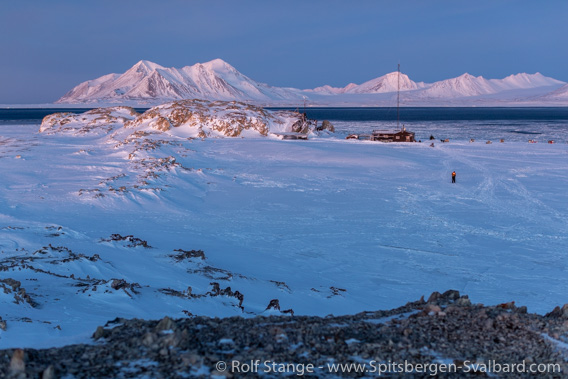
Farmhamna.
This photo gives an impression of Farmhamna at this time, end of January/early February. Around noon, the brightest time of the day.
The light of the north!
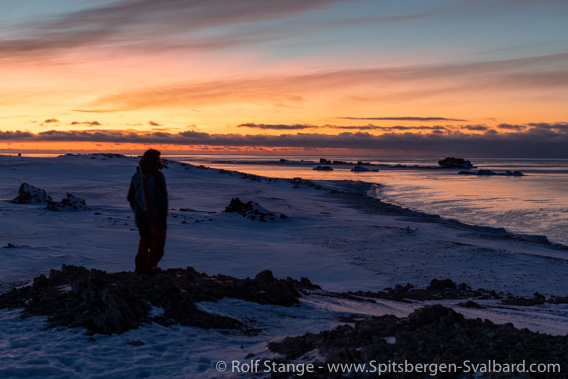
Farmhamna: mid-day twilight.
And here an impression of the outer coast of Farmhamna, looking to the south, around mid-day. There is currently no more than twilight, we won’t see the sun before 16 February at the earliest. Depending on the weather, it may well be later. Or, actually, even a little bit earlier … we’ll see.
In any case, it is still two weeks away. But we have already got several hours of twilight, when the sun travels between 5 and 7 degrees below the horizon, producing the most beautiful shades of yellow, orange and red on the southern sky and all sorts of blue elsewhere.
And there is, as you may expect, sometimes a totally different kind of light shining in the evening. Much weaker than the sun, but infinitely beautiful.
The light of the north!

Northern light above Farmhamna.
A bit weak, but a beautiful start on my very first evening here!
Yes, there may be the odd northern light photo coming up here the next weeks … 🙂
Norway opens up
Norway discontinues most corona restrictions as of today (1st of February) 2300 hrs local time, according to a governmental press release.
This includes significant easements within education, culture and gastronomy, but also for travellers: international travellers do not need to get tested at the border directly after arrival anymore. Fully vaccinated travellers with an accepted vaccination certificate and recovered people with appropriate documentation may enter without test; those who do not have this status need a test taken before departure. Everybody including Norwegian citizens still need to register online before arrival.

corona testing station at Oslo airport Gardermoen: here seen calm, but often very busy.
Soon it will mostly be reliably calm here.
(additional decoration digitally added by the author).
For people travelling to Svalbard, the requirement to get tested in Norway within 24 hours before departure is discontinued for registered lcoal inhabitants as well as fully vaccinated travellers and those who have recovered from a recent Covid-19 infection (accepted documentation needed in any case). The requirement to carry out a self test within 24 hours after arrival is still in force.
Everybody is still asked to keep a distance of one meter or to wear a mask wherever it is not possible to keep this distance.
The Norwegian government plans to discontinue all corona restrictions until 17 February unless new and currently unforeseen developments require a new change of plans.
Northbound
Sun
30 Jan
2022
The light is about to return to high latitudes in the north, and I have the opportunity to follow. Or, actually, to be a bit ahead of it.
Just in case anyone wants to know: travelling from Germany to Norway and further to Longyearbyen was remarkably easy. Somehow I expected some kind of trouble, I was certainly mentally prepared for it. As long as you have registered your planned entry to Norway before you actually come and you are tested negative directly after arrival and again within 24 hours before departure to Longyearbyen, nothing should keep things from going smoothly (it may depend a bit on where you come from – this is by no means legal advice, it is just recent experience). If the time between arrival in Oslo and departure to Longyearbyen is shorter than 24 hours, then one test will do. A lot depends obviously on the amount of traffic in the airport.
Don’t ask me how this may change in the future. Things are likely to change also in Norway sooner rather than later. Generally speaking, there is talk about making things easier. What and for whom, I don’t know.
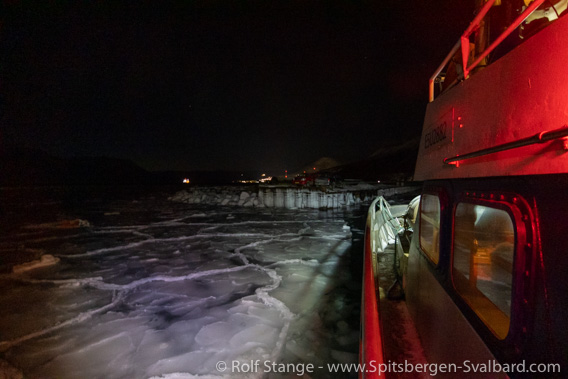
Ice in the harbour of Longsyearbyen (småbåthavna, “small boat harbour”)
My stay in Longyearbyen was short and hectic this time. Shorter and more hectic than planned. Originally, the idea was to have a couple of days here before I would carry on, but this didn’t happen. The boat trip to the place that I was going to was moved to the next rather early morning after my arrival. There wasn’t much time to put the feet on the table, as you may well guess.
The little but sturdy MS Farm of Hennigsen, the only boat on the water here at this – from a sailor’s point of view – ungodly time of year. It was a trip of 6-7 hours, and the challenge started already in the harbour, which was kinf of half frozen. Ice on the water, a fine northern light on the sky. A good way to start a new adventure.
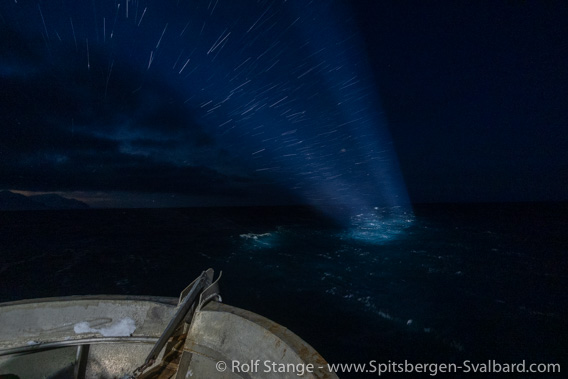
With MS Farm across Isfjord during the polar night.
There are already several hours of daylight around noon, and we managed to arrive at our destination still with some light. Farmhamna on the west coast. Here, I will help Rico for a couple of weeks. He and his partner Karoline own this beautiful trapper station, and here they do theirs to keep the tradition of overwintering hunting alive, which has a history spanning centuries here in Spitsbergen.
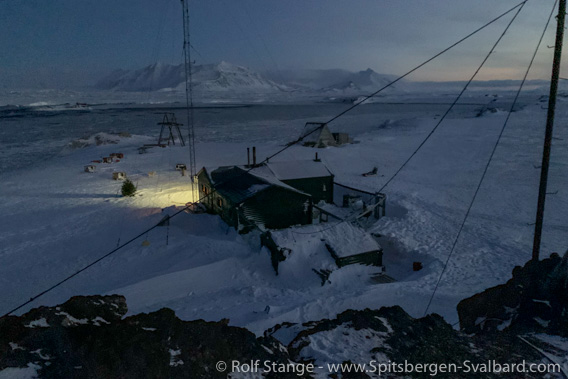
Farmhamna: arrived happily – arrived and happy.
- gallery anchor link: #gallery_2172
Click on thumbnail to open an enlarged version of the specific photo.
The state of affairs
The new is already nearly 4 weeks old. Not too much has happened in Spitsbergen that has really shaken the world, but nevertheless it is time to have a look at the state of affairs.
C & O in Longyearbyen
C as in corona, O as in Omikron – I guess there is hardly anyone who can still hear it without getting turned off. And who will be surprised that C & O are now well established also locally in Longyearbyen? Probably nobody. The numbers of positive tests is well up in two-digit numbers – within a population somewhere near 2500. And it is definitely not just about travellers who just came up with „importsmitte“ (imported infection). The virus is circulating locally, including the school.
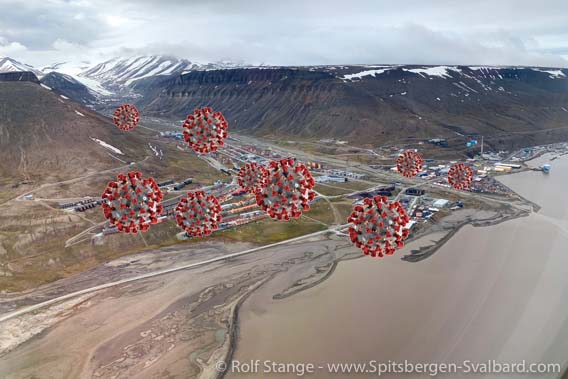
🙁
Nearly everybody travelling up to Svalbard is obliged to take a negative test done in Norway within 24 hours before departure (and another one after arrival), something that locals – population, economy, politicians – are not amused about at all, also considering that this is not the case elsewhere in Norway. And there are those who ask why Svalbard gets a different treatment than the rest of the country. The tourism industry is getting more and more nervous about the important winter season, which has already been largely lost in to consecutive years.
No sabotage on the cables
No, this is not about the deep sea cable that connects Svalbard to the rest of the world which was damaged a few weeks ago. It is still uncertain what has actually happened to it and it will take some time until the damage is located, let alone repaired. But the functionality has at least been restored, so there is redundancy in the communication again and the whole pressure isn’t just resting on the second cable alone anymore.
In this context, the initially mysterious case of a damaged cable on the sea floor off north Norway was also discussed. Sabotage was at least not excluded in either of these cases, and one had to exercise a bit of self discipline in order not to think of Norway’s big and currently rather ill-tempered neighbour in the east (no, not Sweden). But at least for the case near the islands of Vesterålen in north Norway, sabotage seems rather unlikely now, as NRK reports: the still „missing“ bit of the cable was „found“ – indeed it turned out that the part of the cable that was torn off and later found in a distance of 11 kilometres from the original location, was actually complete, so nothing was missing anymore. This was established after the length of the cable could be measured more precisely.
An investigation of the ship traffic in the area at the time in question has resulted in information that points to a fishing vessel as the cause for the cable clutter. This had initially been considered unlikely as it was believed that such an incidence could not have happened unnoticed and that the crew would have reported it, but this has apparently not been the case. As unpleasant as the whole affair still is for everybody involved including those who don’t get the data they need for their scientific work, at least this is one potential strain off from international relations which are difficult enough as they are.
And as mentioned above, it remains to be seen if there is an equally harmless (at least from a point of international politics) explanation for the case of the Svalbard cable.
Polar Permaculture: neither perma nor culture
The business was neither perma(nent) nor was there sufficient culture in it, at least looking at the formal side of affairs: Polar permaculture was an eco-friendly horticulture business growing for example kitchen herbs in a dome in Nybyen. Local and environmentally friendly food production was and still is an idea that many will sympathise with (including this author). But in this case, the attempt, which seemed to work successfully for a couple of years, came to a rather sad end as the company went bankrupt during the corona crisis in spite of public aid. So far so understandable. But the problem is that the whereabouts of substantial amounts of money, from public and private sources, could not be traced – and 2 million Norwegian kroner (about 200,000 Euro) are not small change, obviously. It turned out that „chaotic“ seems to be a rather mild description of the accounting within Polar Permaculture. The Sysselmester is investigating the case according to Svalbardposten, considering to open a legal case against the former company.
And other than that?
That’s it for the moment.
Data connection cable to mainland damaged
Many, many years ago, ships were needed to send messages from Spitsbergen to the world and vice versa. The wireless telegraph station built in 1911 at Finneset made communication considerably more efficient. Further techical upgrades followed throughout the 20th century.
But this kind of connection, although perfectly fine for the everyday needs of mining companies, expeditions and fishing and other ships, was far from good enough for the traffic that arose when SvalSat was established in 1997: a station with a collection of satellite antennas to send data to satellites and receive data traveling the opposite way. The number of antennas at SvalSat has increased ever since and is now amounting to something near 100.
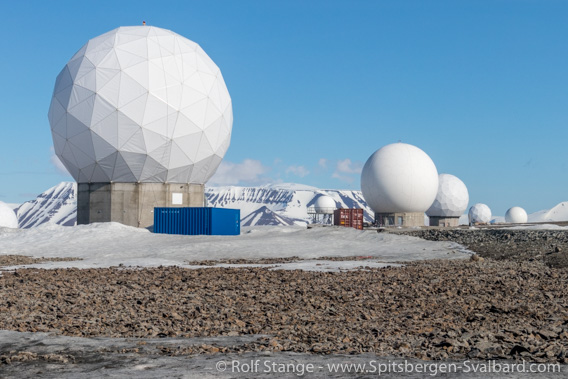
Satellite antennas of SvalSat on Platåberg near Longyearbyen.
As customers like NASA and ESA don’t like to wait until a data DVD or USB stick is shipped out to them, a fibre cable was laid to the mainland in 2004 to transport large volumes of data in real time. It is actually a set of two indipendent cables to create redundancy and thus a robust structure. Since these cables exist, Longyearbyen has super-fast internet (although the user experience of more mertals may occasionally be different).
The two cables on the sea floor are a very important and sensitive bit of infrastructure. Almost all communication of all of Spitsbergen’s settlements depends on them, as well as the data traffic that is going through SvalSat: controlling satellites in polar orbits and receiving their data when they are needed. Navigation, communication, science, weather – the whole lot, everything that satellites do these days. Obviously an important bit of global infrastructure.
Last Friday, one of the cables was damaged in the early morning, as the operating company Space Norway notified in a press release. A sea-going cable laying vessel is needed to repair the damage, and it will take time until this is done.
The second cable is enough to cater for all data traffic and there are no restrictions as long as it is operative. But there is no further redundance, and a loss of the second cable would have huge consequences. A crisis management group had a first meeting in Longyearbyen to discuss scenarios “in case”. Officials emphasise, however, that there is no reason to believe that a loss of the second cable is likely to happen.
The damage seems to have occured at a distance between 120-130 km from Longyearbyen, in an area where depth is falling from the shallower shelf to the deep sea. The continental shelf is an area where huge mass movements naturally occur from time to time, so the damage may have been caused by a natural event. But no further details are known so far, and authorities do not exclude criminally relevant action of third parties, according to NRK.
The case reminds of the mysterious loss of a cable connection of research installations on the sea floor off north Norway. Last year, the “Lofoten-Vesterålen Meeresobservatorium”, or short: “LoVe” suddenly turned black. LoVe is a civilian research facility designed to collect a rather comprehensive set of high-resolution data of various sorts, including acoustic data. LoVe is, in other words, capable of recording submarine traffic at least to some degree. It turned out that no less than 4 kilometres of cable were removed. 3 out of these 4 km of cable were later found in a distance of a good 10 km from the original site. A natural cause for the event can, as of now, not be excluded, although all options considered (including currents, giant squid or whales) sound more or less bizarre. Bottom trawling can not be ruled out either, but it is hard to imagine that this would have happened unnoticed.
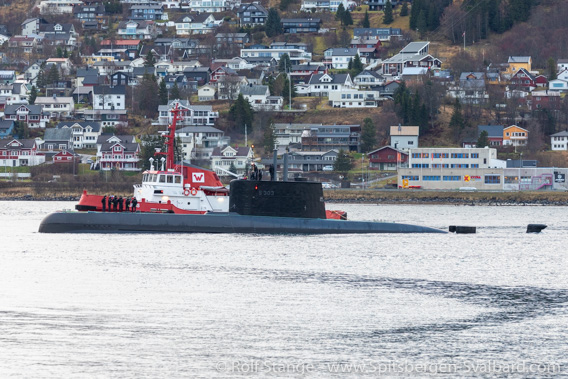
There is a lot of submarine traffic off Norway. Not all of them operate as much in public as this submarine that is here seen being towed in the harbour of Tromsø.
In this context, remarks have been made that Russia is technically capable of operations on the sea floor at relevant depths. Norwegian authorities including the secret service are involved in the investigations, as was reported by NRK and international media such as German SPIEGEL Online.
These cases shed a different kind of light on the desire of the Norwegian military to control high-resolution mapping of the Norwegian sea floor including Svalbard and Jan Mayen.
News-Listing live generated at 2025/May/03 at 14:26:07 Uhr (GMT+1)
